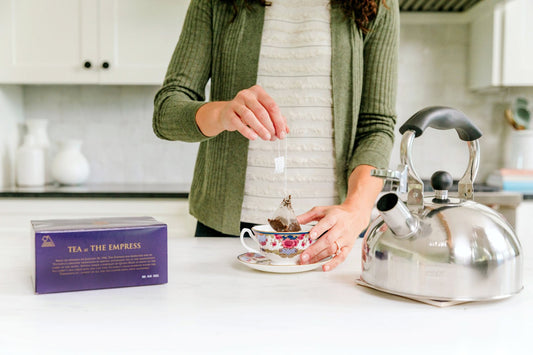The Perfect Cup Of Tea

Sitting down to a hot, soothing cup of tea is a universal pleasure. Tea is the world’s most popular beverage, and each country has its own tea traditions. And, it’s often misunderstood according to James Norwood Pratt, a San Francisco tea expert.
Tea gets compared to coffee, but it’s more like wine, says Pratt. Both are influenced by location, terroir, and climate. “Wine and tea are sister products… which at best can become works of art.” Pratt should know: He wrote the Tea Lover’s Treasury, the first book to discuss the nuances of the aroma, flavor, and terroir of tea.
In the U.S., tea culture continues to gather steam. We’ve adopted a potpourri of international tea traditions since it was introduced in 1650, including English afternoon tea, Japanese matcha, and Chinese tea at dim sum. In 1982, when Pratt released his book, the U.S. tea market was valued as just under $1 billion annually. In 2020, it will exceed $17 billion, according to The Tea Association of the USA.
True tea only comes from the camellia sinensis plant, a leafy tree or shrub native to China that also thrives in Japan, Thailand, Burma, and India. The leaves are picked and then processed in different ways to create white, green, oolong, and black teas.
Pratt shared this primer on different types of tea, plus fascinating origin stories, to guide you as you shop and sip.
White Tea
If you’re looking for a delicately flavored sip, try a white tea. The youngest buds are plucked before they have a chance to turn green, and they are dried in the sun.
Green Tea
High-quality green tea leaves are picked in the early morning and then enjoyed as a verdant tea from leaves that are withered and heat-dried that afternoon. The place where the tea is grown shapes the flavor. The most prized green teas come from Japan and China, and there are also varieties produced in India and Africa.
Matcha is a green tea that starts with leaves that are dried and ground to a fine powder. It has become a popular product in the U.S. The finest matcha tea comes from Japan near Kyoto. It should be brilliant green with a flavor that Pratt calls an “indefinable” blend of floral, vegetal, fruity, and bitter.
The most popular scented tea in China is Jasmine Green. Closed jasmine blossoms are harvested and spread on trays. One by one, they open at midnight. “When you’re in a place where they’re making jasmine tea, you begin to hear this faint popping sound. It’s … millions of little jasmine blossoms popping open,” says Pratt. Tea artisans layer the blooms with dried green tea leaves to infuse the tea.
Black Tea
Wondering about the difference between green and black tea? Black tea starts like green tea, but the leaves are bruised to release juice and fragrant oils. It’s allowed to oxidize and turn dark, giving it deeper flavors that vary depending on where it's grown.
Its beguiling fragrance makes Earl Grey the most beloved scented black tea in the West. In the 1830s, British Prime Minister Charles Grey was given tea scented with Italian Bergamot limes. “Earl Grey belongs on every good tea menu,” says Pratt.
English Breakfast and Imperial Breakfast are commercial names that don't refer to a specific type of tea, so any black tea can bear those names. These teas can hail from Asia, India, or Africa.
Did you know there’s no orange in Orange Pekoe? The “pekoe” refers to the very largest tea leaves, which are fermented into black tea. Pratt says it originated in Holland, where it became fashionable after people heard the royal House of Orange drank it.
Oolong has its own category, a partially fermented tea, which is halfway between green and black tea. “Oolong is deliciously aromatic,” says Pratt.
Herbs, Flowers, and Fruits: Our Favorite Tisanes
While we call mint, chamomile and rooibos “tea” since they’re steeped in hot water, each of these are really tisanes, a French term for caffeine-free beverages made from botanicals such as herbs, flowers, and fruit.
Rooibos comes from a red bushy plant native to South Africa. Lot 35’s Rooibos tea is reddish with a natural fruity, vanilla note. Chamomile is a flower in the daisy family, which has a soft, earthy scent and the power to induce calm. Some of the best chamomile grows in Egypt’s fertile Nile River delta.
Mate is all the rage in Brazil, Argentina, Paraguay and Uruguay, where the earthy drink eclipses coffee or Asian tea. Twigs and leaves from the yerba mate (ilex paraguariensis) bush are dried and steeped into a drink that South Americans say sustains energy and good health.
No matter which tea you prefer, choose one that’s made with natural flavors that reveal the place where it was sourced. “In the end, all you can say about tea is it comes from someplace else and it takes us someplace else,” says Pratt.
About the Author
Maria Hunt is a lifestyle journalist and author specializing in interior design, cuisine and travel. Her work has appeared in The New York Times, Christian Science Monitor, and Forbes Travel Guide, plus she’s the hostess of The Bubbly Girl.com.


